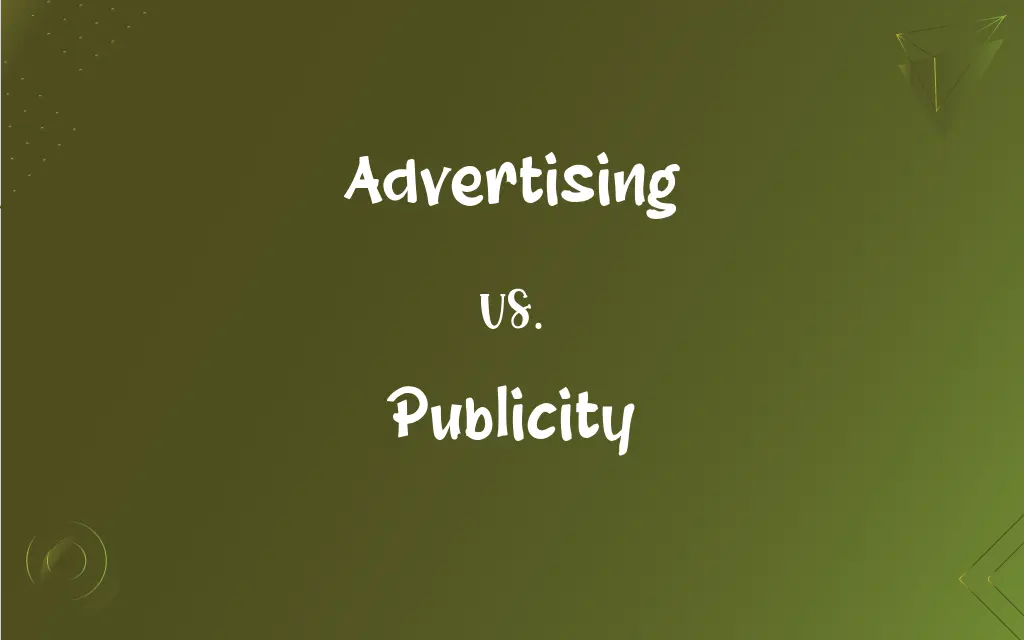Advertising vs. Publicity: What's the Difference?
Edited by Janet White || By Harlon Moss || Updated on October 21, 2023
Advertising is paid promotion of goods/services, while publicity is unpaid media attention, often stemming from news or events.

Key Differences
Advertising is a means through which companies pay to promote their products, services, or brands. It's a controlled method where the advertiser dictates the message, medium, and duration. Publicity, on the other hand, refers to the attention a brand or product gets from the media, without any direct payment involved.
In the world of advertising, companies craft specific messages they want to share with their target audience. This could be through TV commercials, radio ads, online banners, or print media. With publicity, the message is not directly controlled by the brand or company, but by journalists or media houses based on newsworthiness.
Cost is a defining factor in advertising, where every slot, space, or second comes with a price tag. The company pays for visibility. In contrast, publicity is essentially free, originating from press releases, media coverage, or events, but there might be indirect costs like hiring a public relations firm.
The intent of advertising is often direct and clear: to boost sales, increase brand awareness, or promote a particular viewpoint. Publicity, although it can be beneficial, can sometimes be negative, depending on the nature of the news or event it's stemming from.
While both advertising and publicity aim to increase brand awareness and foster a connection with the audience, they differ in approach, cost, control, and sometimes, outcome. Companies often leverage both, balancing controlled messaging with organic media attention.
ADVERTISEMENT
Comparison Chart
Control
Controlled by the advertiser
Not directly controlled by the brand/company
Cost
Paid promotion
Essentially free, though might have indirect costs
Intent
Direct and clear, aiming to boost sales or brand awareness
Can be positive or negative, based on news or events
Origin
Comes from deliberate campaigns
Stems from news, events, or media coverage
Message Dictation
Company dictates the specific message
Media or journalists control the message based on newsworthiness
ADVERTISEMENT
Advertising and Publicity Definitions
Advertising
Intended to persuade or inform an audience.
Effective advertising can lead to increased sales.
Publicity
Not directly controlled by the company or brand.
Despite their efforts, they couldn't control the negative publicity.
Advertising
Paid promotion of a product, service, or brand.
The new soda campaign's advertising was everywhere.
Publicity
Often results from press releases, events, or media coverage.
The charity event generated a lot of positive publicity.
Advertising
A controlled form of marketing communication.
Advertising agencies work to craft the perfect message for clients.
Publicity
Highlights newsworthiness over a crafted message.
The startup's innovative approach garnered them significant publicity.
Advertising
Often has a specific target audience.
The advertising was aimed at young adults between 18 and 25.
Publicity
Can be positive or negative based on news or events.
Negative publicity from the scandal hurt the company's reputation.
Advertising
Uses various mediums like TV, radio, and online platforms.
The product launch included heavy online advertising.
Publicity
Unpaid attention a brand or individual receives from the media.
The movie gained huge publicity after the award nominations.
Advertising
The activity of attracting public attention to a product or business, as by paid announcements in the print, broadcast, or electronic media.
Publicity
Public interest, notice, or notoriety generated or gained by disseminating information through various media
The book has received widespread publicity.
FAQs
Which has a more controlled message: advertising or publicity?
Advertising offers more control over the message than publicity.
Do companies always prefer positive publicity?
Generally, yes, but sometimes "any publicity is good publicity" if it increases visibility.
Is publicity always free?
It's unpaid media attention, but there can be indirect costs like hiring PR firms.
Can advertising be done on social media?
Yes, platforms like Facebook and Instagram offer advertising opportunities.
Can negative publicity benefit a brand?
Sometimes, if it leads to greater visibility or sparks a positive change.
How can a brand handle negative publicity?
Through crisis management, clear communication, and sometimes, public apologies.
Can a company choose to avoid advertising?
Yes, some companies rely more on organic growth and word of mouth.
What's the main difference between advertising and publicity?
Advertising is paid, controlled promotion, while publicity is unpaid, uncontrolled media attention.
Which lasts longer, an advertisement or publicity?
It varies, but while advertisements have set durations, publicity can have lasting impacts.
How do companies measure the effectiveness of advertising?
Through metrics like ROI, brand recall, and sales conversions.
Which industries rely heavily on advertising?
Consumer goods, tech, automotive, and entertainment, among others.
Why do some companies hire public relations (PR) firms?
PR firms help manage publicity, craft communication strategies, and handle media relations.
Is all publicity beneficial in the long run?
Not necessarily; extremely negative publicity can harm a brand's reputation permanently.
Can a single event generate both positive and negative publicity?
Yes, depending on various perspectives and media interpretations.
How important is consistency in advertising?
Very; consistent messaging helps in reinforcing brand identity.
Can publicity be planned?
While you can plan events or press releases, the resulting publicity is not guaranteed.
Which offers more credibility: advertising or publicity?
Publicity, especially from trusted sources, often offers more credibility than ads.
How do advertisements differ across platforms?
Each platform has unique demographics and algorithms, requiring tailored advertising strategies.
Which is more expensive: advertising or publicity?
Advertising typically involves direct costs, while publicity has indirect or no costs.
Can a publicity stunt replace advertising?
Sometimes, if it garners enough attention, but it's riskier due to unpredictability.
About Author
Written by
Harlon MossHarlon is a seasoned quality moderator and accomplished content writer for Difference Wiki. An alumnus of the prestigious University of California, he earned his degree in Computer Science. Leveraging his academic background, Harlon brings a meticulous and informed perspective to his work, ensuring content accuracy and excellence.
Edited by
Janet WhiteJanet White has been an esteemed writer and blogger for Difference Wiki. Holding a Master's degree in Science and Medical Journalism from the prestigious Boston University, she has consistently demonstrated her expertise and passion for her field. When she's not immersed in her work, Janet relishes her time exercising, delving into a good book, and cherishing moments with friends and family.































































